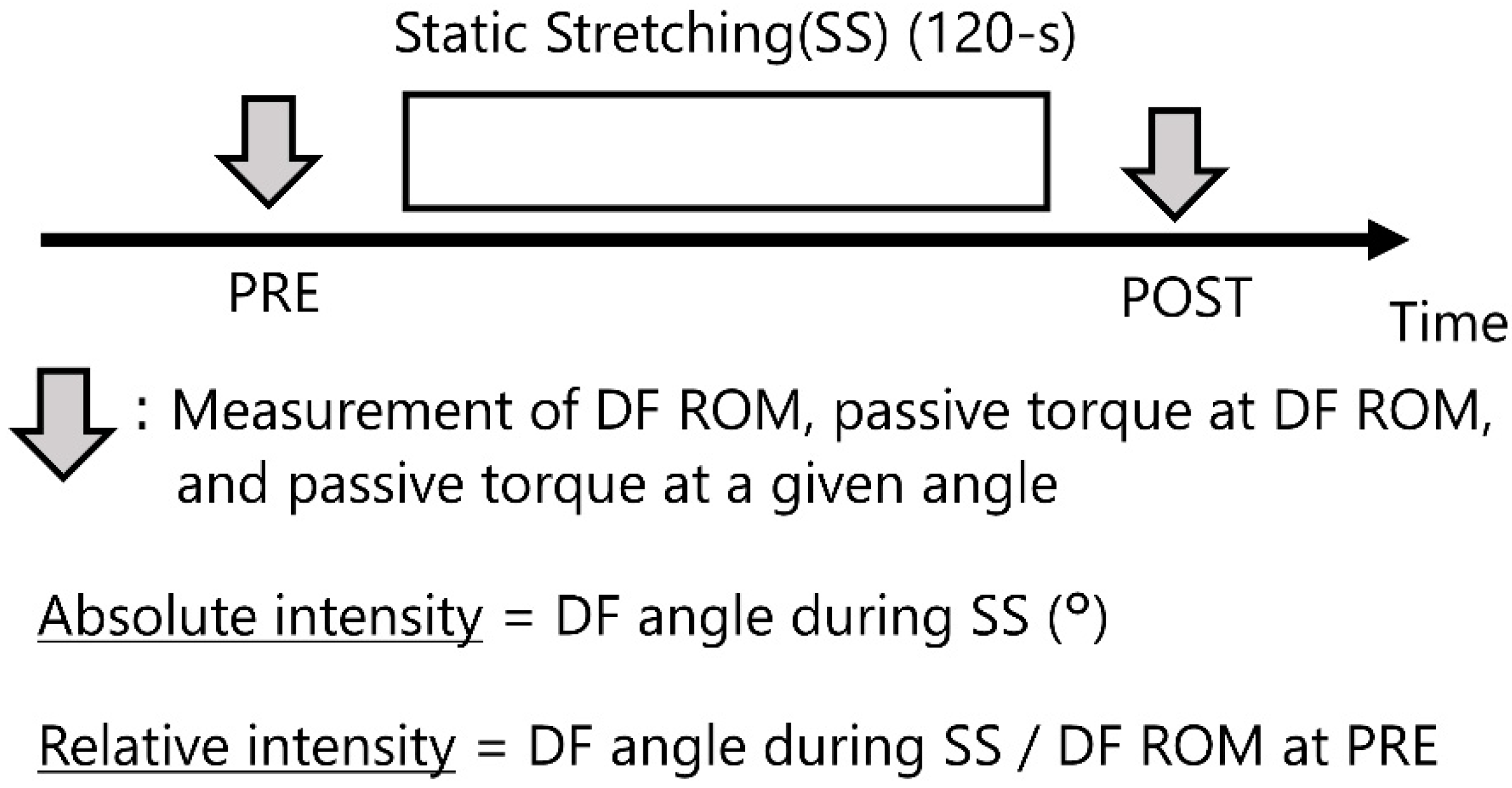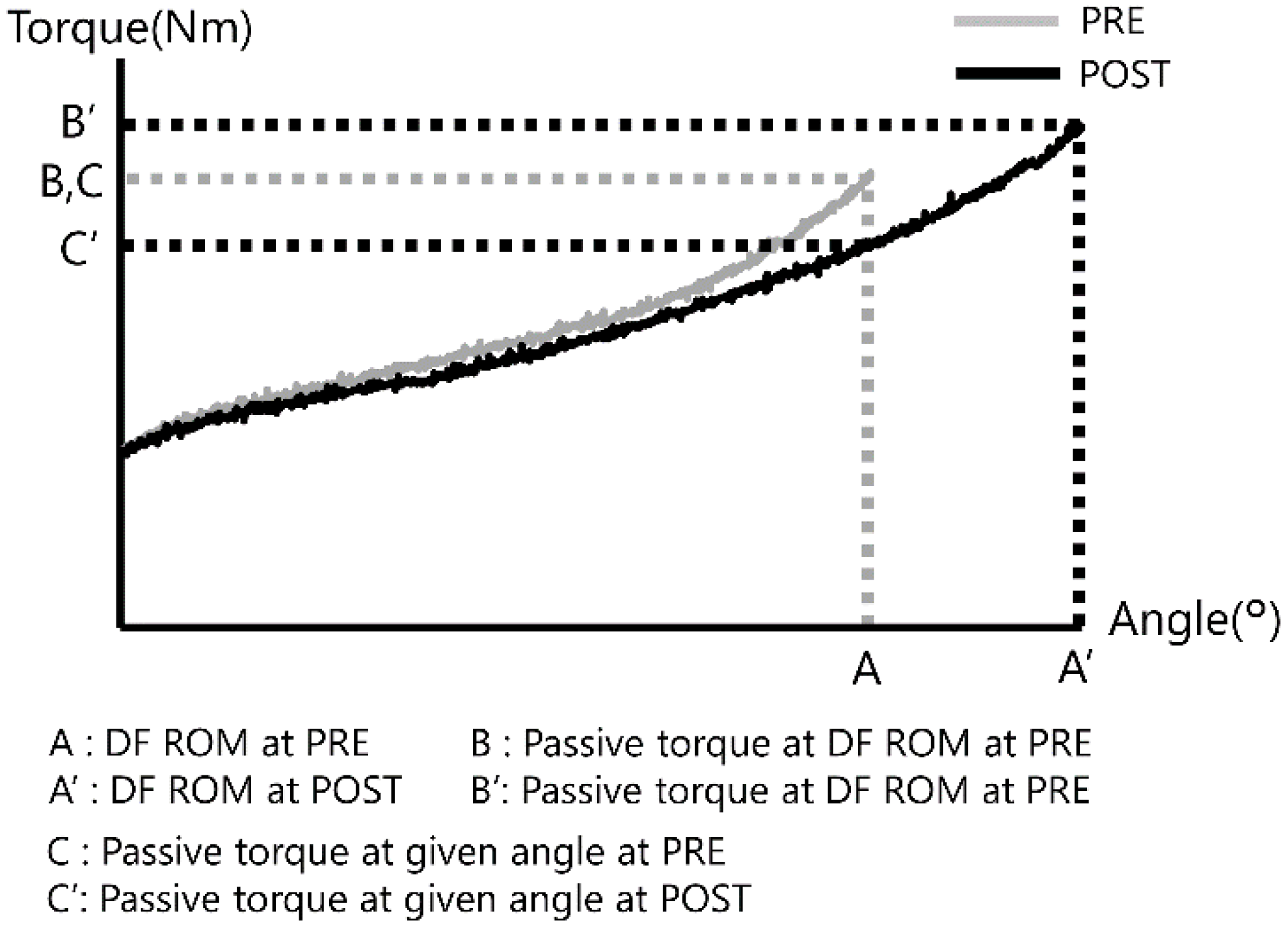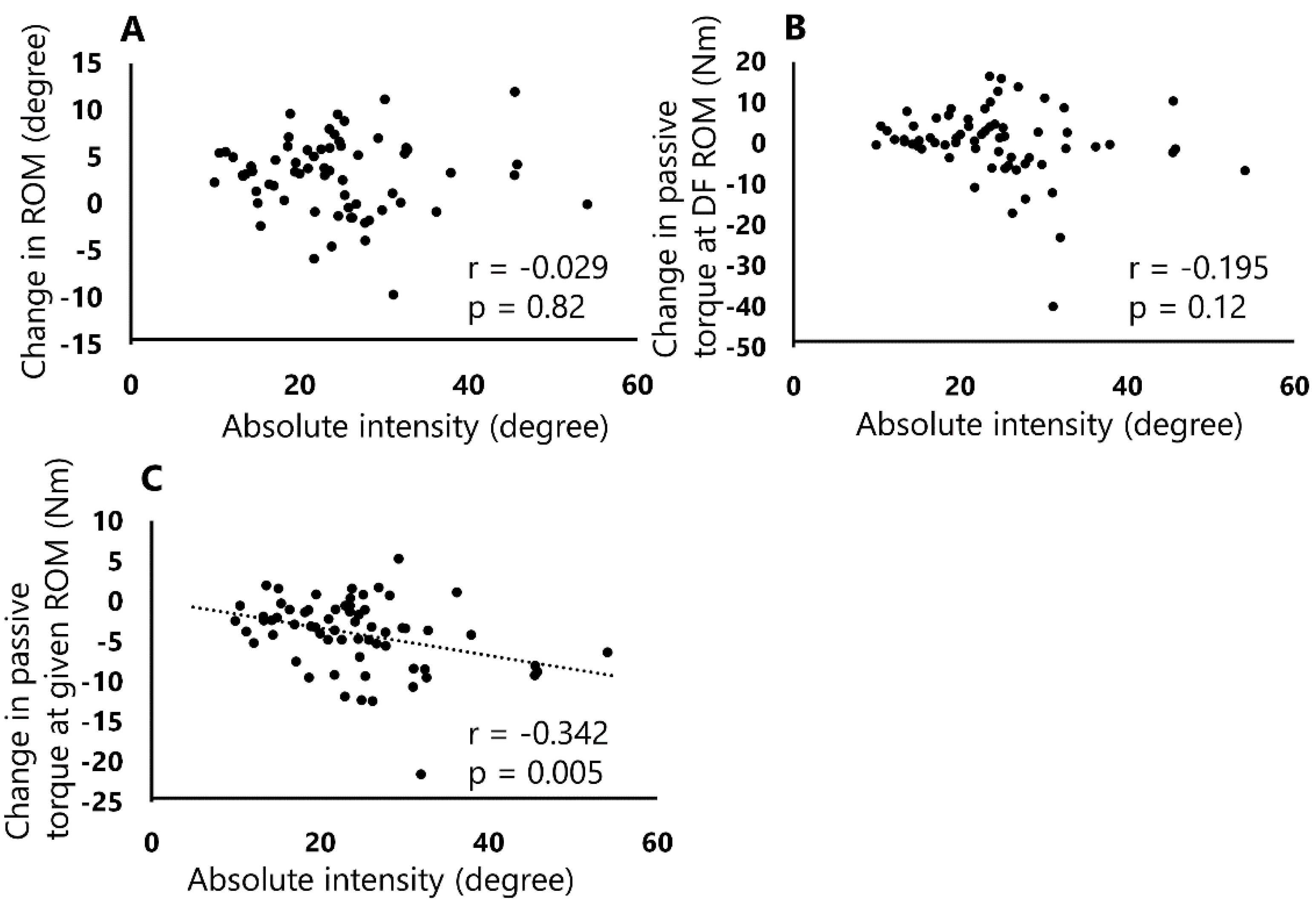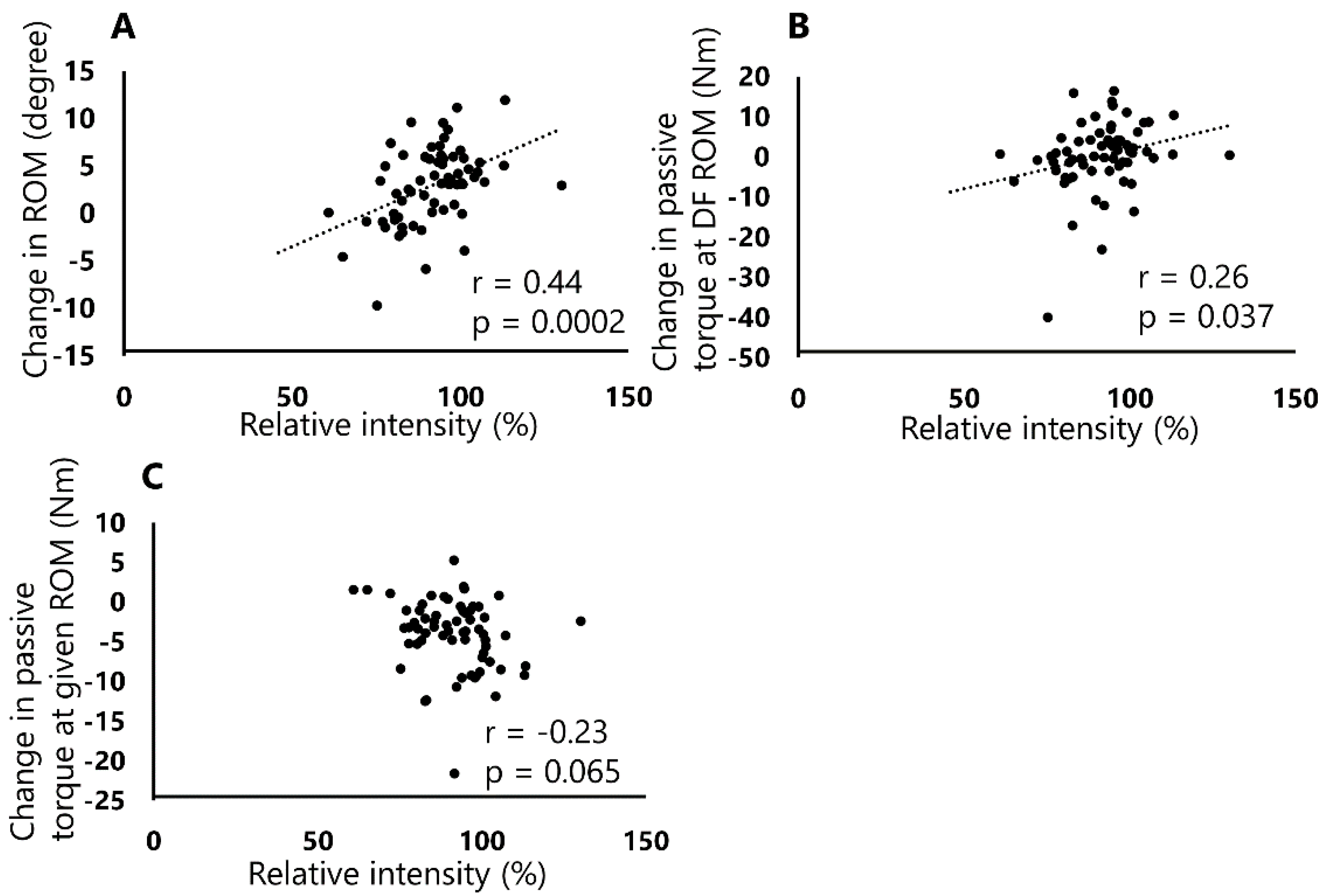The Relationship between Stretching Intensity and Changes in Passive Properties of Gastrocnemius Muscle-Tendon Unit after Static Stretching
Abstract
1. Introduction
2. Materials and Methods
2.1. Participants
2.2. Study Design and Overview
2.3. Procedures
2.4. Static Stretching
2.5. Definition of Stretching Intensity
2.6. Measurement Reliability
2.7. Statistical Analyses
3. Results
3.1. Effect of Static Stretching on Dorsiflexion Range of Motion, Passive Torque at Dorsiflexion Range of Motion, and Passive Torque at a Given Angle
3.2. Relationship between Stretching Intensities and the Changes in Passive Property of Muscle-Tendon Unit
4. Discussion
5. Conclusions
Author Contributions
Funding
Conflicts of Interest
References
- Hemmerich, A.; Brown, H.; Smith, S.; Marthandam, S.S.; Wyss, U.P. Hip, knee, and ankle kinematics of high range of motion activities of daily living. J. Orthop. Res. 2006, 24, 770–781. [Google Scholar] [CrossRef] [PubMed]
- Mulholland, S.J.; Wyss, U.P. Activities of daily living in non-western cultures: Range of motion requirements for hip and knee joint implants. Int. J. Rehabil. Res. 2001, 24, 191–198. [Google Scholar] [CrossRef] [PubMed]
- Witvrouw, E.; Danneels, L.; Asselman, P.; D’Have, T.; Cambier, D. Muscle flexibility as a risk factor for developing muscle injuries in male professional soccer players. A prospective study. Am. J. Sports Med. 2003, 31, 41–46. [Google Scholar] [CrossRef]
- Behm, D.G.; Blazevich, A.J.; Kay, A.D.; McHugh, M. Acute effects of muscle stretching on physical performance, range of motion, and injury incidence in healthy active individuals: A systematic review. Appl. Physiol. Nutr. Metab. 2016, 41, 1–11. [Google Scholar] [CrossRef] [PubMed]
- Apostolopoulos, N.; Metsios, G.S.; Flouris, A.D.; Koutedakis, Y.; Wyon, M.A. The relevance of stretch intensity and position—A systematic review. Front. Psychol. 2015, 6, 1128. [Google Scholar] [CrossRef]
- Matsuo, S.; Suzuki, S.; Iwata, M.; Banno, Y.; Asai, Y.; Tsuchida, W.; Inoue, T. Acute effects of different stretching durations on passive torque, mobility, and isometric muscle force. J. Strength Cond. Res. 2013, 27, 3367–3376. [Google Scholar] [CrossRef] [PubMed]
- Nakamura, M.; Ikezoe, T.; Takeno, Y.; Ichihashi, N. Time course of changes in passive properties of the gastrocnemius muscle-tendon unit during 5 min of static stretching. Man. Ther. 2013, 18, 211–215. [Google Scholar] [CrossRef]
- Freitas, S.R.; Vilarinho, D.; Rocha Vaz, J.; Bruno, P.M.; Costa, P.B.; Mil-homens, P. Responses to static stretching are dependent on stretch intensity and duration. Clin. Physiol. Funct. Imaging 2015, 35, 478–484. [Google Scholar] [CrossRef]
- Kataura, S.; Suzuki, S.; Matsuo, S.; Hatano, G.; Iwata, M.; Yokoi, K.; Tsuchida, W.; Banno, Y.; Asai, Y. Acute effects of the different intensity of static stretching on flexibility and isometric muscle force. J. Strength Cond. Res. 2017, 31, 3403–3410. [Google Scholar] [CrossRef]
- Santos, C.X.; Beltrao, N.B.; Piraua, A.L.T.; Durigan, J.L.Q.; Behm, D.; de Araujo, R.C. Static stretching intensity does not influence acute range of motion, passive torque, and muscle architecture. J. Sport Rehabil. 2020, 29, 1–6. [Google Scholar] [CrossRef]
- Freitas, S.R.; Andrade, R.J.; Larcoupaille, L.; Mil-homens, P.; Nordez, A. Muscle and joint responses during and after static stretching performed at different intensities. Eur. J. Appl. Physiol. 2015, 115, 1263–1272. [Google Scholar] [CrossRef] [PubMed]
- Halbertsma, J.P.; Goeken, L.N. Stretching exercises: Effect on passive extensibility and stiffness in short hamstrings of healthy subjects. Arch. Phys. Med. Rehabil. 1994, 75, 976–981. [Google Scholar] [CrossRef]
- Freitas, S.R.; Vaz, J.R.; Bruno, P.M.; Andrade, R.; Mil-Homens, P. Stretching effects: High-intensity & moderate-duration vs. low-intensity & long-duration. Int. J. Sports Med. 2016, 37, 239–244. [Google Scholar] [CrossRef] [PubMed]
- Mizuno, T.; Matsumoto, M.; Umemura, Y. Viscoelasticity of the muscle-tendon unit is returned more rapidly than range of motion after stretching. Scand. J. Med. Sci. Sports 2013, 23, 23–30. [Google Scholar] [CrossRef] [PubMed]
- Morse, C.I.; Degens, H.; Seynnes, O.R.; Maganaris, C.N.; Jones, D.A. The acute effect of stretching on the passive stiffness of the human gastrocnemius muscle tendon unit. J. Physiol. 2008, 586, 97–106. [Google Scholar] [CrossRef]
- Toft, E.; Espersen, G.T.; Kalund, S.; Sinkjaer, T.; Hornemann, B.C. Passive tension of the ankle before and after stretching. Am. J. Sports Med. 1989, 17, 489–494. [Google Scholar] [CrossRef]
- Magnusson, S.P.; Simonsen, E.B.; Aagaard, P.; Gleim, G.W.; McHugh, M.P.; Kjaer, M. Viscoelastic response to repeated static stretching in the human hamstring muscle. Scand. J. Med. Sci. Sports 1995, 5, 342–347. [Google Scholar] [CrossRef]
- Nakamura, M.; Ikezoe, T.; Kobayashi, T.; Umegaki, H.; Takeno, Y.; Nishishita, S.; Ichihashi, N. Acute effects of static stretching on muscle hardness of the medial gastrocnemius muscle belly in humans: An ultrasonic shear-wave elastography study. Ultrasound Med. Biol. 2014, 40, 1991–1997. [Google Scholar] [CrossRef]
- Young, W.; Elias, G.; Power, J. Effects of static stretching volume and intensity on plantar flexor explosive force production and range of motion. J. Sports Med. Phys. Fit. 2006, 46, 403–411. [Google Scholar]
- Landis, J.R.; Koch, G.G. The measurement of observer agreement for categorical data. Biometrics 1977, 33, 159–174. [Google Scholar] [CrossRef]
- Blazevich, A.J.; Cannavan, D.; Waugh, C.M.; Fath, F.; Miller, S.C.; Kay, A.D. Neuromuscular factors influencing the maximum stretch limit of the human plantar flexors. J. Appl. Physiol. 2012, 113, 1446–1455. [Google Scholar] [CrossRef] [PubMed]
- Kay, A.D.; Husbands-Beasley, J.; Blazevich, A.J. Effects of contract-relax, static stretching, and isometric contractions on muscle-tendon mechanics. Med. Sci. Sports Exerc. 2015, 47, 2181–2190. [Google Scholar] [CrossRef] [PubMed]
- Folpp, H.; Deall, S.; Harvey, L.A.; Gwinn, T. Can apparent increases in muscle extensibility with regular stretch be explained by changes in tolerance to stretch? Aust. J. Physiother. 2006, 52, 45–50. [Google Scholar] [CrossRef]
- Law, R.Y.; Harvey, L.A.; Nicholas, M.K.; Tonkin, L.; De Sousa, M.; Finniss, D.G. Stretch exercises increase tolerance to stretch in patients with chronic musculoskeletal pain: A randomized controlled trial. Phys. Ther. 2009, 89, 1016–1026. [Google Scholar] [CrossRef]
- Backman, L.J.; Danielson, P. Low range of ankle dorsiflexion predisposes for patellar tendinopathy in junior elite basketball players: A 1-year prospective study. Am. J. Sports Med. 2011, 39, 2626–2633. [Google Scholar] [CrossRef]
- Witvrouw, E.; Bellemans, J.; Lysens, R.; Danneels, L.; Cambier, D. Intrinsic risk factors for the development of patellar tendinitis in an athletic population. A two-year prospective study. Am. J. Sports Med. 2001, 29, 190–195. [Google Scholar] [CrossRef] [PubMed]
- Pickering Rodriguez, E.C.; Watsford, M.L.; Bower, R.G.; Murphy, A.J. The relationship between lower body stiffness and injury incidence in female netballers. Sports Biomech. 2017, 16, 361–373. [Google Scholar] [CrossRef]
- Watsford, M.L.; Murphy, A.J.; McLachlan, K.A.; Bryant, A.L.; Cameron, M.L.; Crossley, K.M.; Makdissi, M. A prospective study of the relationship between lower body stiffness and hamstring injury in professional Australian rules footballers. Am. J. Sports Med. 2010, 38, 2058–2064. [Google Scholar] [CrossRef]
- Miyamoto, N.; Hirata, K.; Miyamoto-Mikami, E.; Yasuda, O.; Kanehisa, H. Associations of passive muscle stiffness, muscle stretch tolerance, and muscle slack angle with range of motion: Individual and sex differences. Sci. Rep. 2018, 8, 8274. [Google Scholar] [CrossRef]
- Ryan, E.D.; Herda, T.J.; Costa, P.B.; Defreitas, J.M.; Beck, T.W.; Stout, J.; Cramer, J.T. Determining the minimum number of passive stretches necessary to alter musculotendinous stiffness. J. Sports Sci. 2009, 27, 957–961. [Google Scholar] [CrossRef]
- Takeuchi, K.; Nakamura, M. Influence of high intensity 20-second static stretching on the flexibility and strength of hamstrings. J. Sports Sci. Med. 2020, 19, 429–435. [Google Scholar] [PubMed]
- Freitas, S.R.; Mendes, B.; Le Sant, G.; Andrade, R.J.; Nordez, A.; Milanovic, Z. Can chronic stretching change the muscle-tendon mechanical properties? A review. Scand. J. Med. Sci. Sports 2018, 28, 794–806. [Google Scholar] [CrossRef] [PubMed]




Publisher’s Note: MDPI stays neutral with regard to jurisdictional claims in published maps and institutional affiliations. |
© 2020 by the authors. Licensee MDPI, Basel, Switzerland. This article is an open access article distributed under the terms and conditions of the Creative Commons Attribution (CC BY) license (http://creativecommons.org/licenses/by/4.0/).
Share and Cite
Fukaya, T.; Nakamura, M.; Sato, S.; Kiyono, R.; Yahata, K.; Inaba, K.; Nishishita, S.; Onishi, H. The Relationship between Stretching Intensity and Changes in Passive Properties of Gastrocnemius Muscle-Tendon Unit after Static Stretching. Sports 2020, 8, 140. https://doi.org/10.3390/sports8110140
Fukaya T, Nakamura M, Sato S, Kiyono R, Yahata K, Inaba K, Nishishita S, Onishi H. The Relationship between Stretching Intensity and Changes in Passive Properties of Gastrocnemius Muscle-Tendon Unit after Static Stretching. Sports. 2020; 8(11):140. https://doi.org/10.3390/sports8110140
Chicago/Turabian StyleFukaya, Taizan, Masatoshi Nakamura, Shigeru Sato, Ryosuke Kiyono, Kaoru Yahata, Kazuki Inaba, Satoru Nishishita, and Hideaki Onishi. 2020. "The Relationship between Stretching Intensity and Changes in Passive Properties of Gastrocnemius Muscle-Tendon Unit after Static Stretching" Sports 8, no. 11: 140. https://doi.org/10.3390/sports8110140
APA StyleFukaya, T., Nakamura, M., Sato, S., Kiyono, R., Yahata, K., Inaba, K., Nishishita, S., & Onishi, H. (2020). The Relationship between Stretching Intensity and Changes in Passive Properties of Gastrocnemius Muscle-Tendon Unit after Static Stretching. Sports, 8(11), 140. https://doi.org/10.3390/sports8110140





